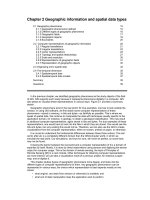Lecture 03,04,05 intensity transformation and spatial filtering
Bạn đang xem bản rút gọn của tài liệu. Xem và tải ngay bản đầy đủ của tài liệu tại đây (3 MB, 46 trang )
Intensity transformation and spatial filtering
Digital Image Processing
Lecture 3 – Intensity
Transformation& Spatial Filtering
Lecturer: Ha Dai Duong
Faculty of Information Technology
I. Introduction
Spatial Domain vs. Transform Domain
Spatial Domain
Image plane itself, directly process the intensity values of the
image plane
Transform (Frequency) domain
Process the transform coefficients, not directly process the
intensity values of the image plane
Digital Image Processing
2
1
Intensity transformation and spatial filtering
I. Introduction
Spatial Domain Process
g ( x, y ) = T [ f ( x, y )])
f ( x, y ) : input image
g ( x, y ) : output image
T : an operator on f defined over
a neighborhood of point ( x, y )
Digital Image Processing
3
I. Introduction
Spatial Domain Process
Digital Image Processing
4
2
Intensity transformation and spatial filtering
II. Intensity transformation function
Intensity transformation function
s = T (r )
5
Digital Image Processing
II. Intensity transformation function
Some
basic
Functions
Digital Image Processing
intensity
transformation
6
3
Intensity transformation and spatial filtering
II.1. Negative
Image negatives
s = L −1− r
Digital Image Processing
7
II.1. Negative
Small
lesion
Digital Image Processing
8
4
Intensity transformation and spatial filtering
II.2. Log Transform
Log Transformations
s = c log(1 + r )
Digital Image Processing
9
II.2. Log Transform
Digital Image Processing
10
5
Intensity transformation and spatial filtering
II.3. Power – Law
s = cr γ
Digital Image Processing
11
II.3. Power – Law
Digital Image Processing
12
6
Intensity transformation and spatial filtering
II.3. Power – Law
Digital Image Processing
13
II.4. Piecewise-Linear Transform..
Contrast Stretching
Expands the range of intensity levels in an image so
that it spans the full intensity range of the recording
medium or display device
Intensity-level Slicing
Highlighting a specific range of intensities in an image
often is of interest
Digital Image Processing
14
7
Intensity transformation and spatial filtering
II.4. Piecewise-Linear Transform…
Digital Image Processing
15
Digital Image Processing
16
8
Intensity transformation and spatial filtering
II.5. Bit – Plane Slicing
Digital Image Processing
17
II.5. Bit – Plane Slicing
Digital Image Processing
18
9
Intensity transformation and spatial filtering
III. Histogram processing
Histogram Equalization
Histogram Matching
Local Histogram Processing
Using
Histogram
Statistics
Enhancement
Digital Image Processing
for
Image
19
III. Histogram processing
Histogram h(rk ) = nk
rk is the k th intensity value
nk is the number of pixels in the image with intensity rk
nk
MN
nk : the number of pixels in the image of
Normalized histogram p (rk ) =
size M × N with intensity rk
Digital Image Processing
20
10
Intensity transformation and spatial filtering
III. Histogram processing
No. of pixels
6
2
3
3
2
4
2
4
3
3
2
3
5
2
4
2
4
4x4 image
Gray scale = [0,9]
5
4
3
2
1
Gray level
0 1 2 3 4 5 6 7 8 9
Digital Image Processing
histogram
21
III. Histogram processing
Digital Image Processing
22
11
Intensity transformation and spatial filtering
III.1. Histogram Equalization
As the low-contrast image’s histogram is narrow
and centered toward the middle of the gray scale,
if we distribute the histogram to a wider range the
quality of the image will be improved.
We can do it by adjusting the probability density
function of the original histogram of the image so
that the probability spread equally
23
Digital Image Processing
III.1. Histogram Equalization
Histogram transformation
s = T(r)
s
Where 0 ≤ r ≤ 1
T(r) satisfies
sk= T(rk)
T(r)
0
rk
Digital Image Processing
1
(a). T(r) is single-valued
and monotonically
increasingly in the interval
0≤r≤1
(b). 0 ≤ T(r) ≤ 1 for
0≤r≤1
r
24
12
Intensity transformation and spatial filtering
III.1. Histogram Equalization
2 conditions of T(r)
Single-valued (one-to-one relationship) guarantees that
the inverse transformation will exist
Monotonicity condition preserves the increasing order from
black to white in the output image thus it won’t cause a
negative image
0 ≤ T(r) ≤ 1 for 0 ≤ r ≤ 1 guarantees that the output gray
levels will be in the same range as the input levels.
The inverse transformation from s back to r is
r = T -1(s) ; 0 ≤ s ≤ 1
25
Digital Image Processing
III.1. Histogram Equalization
Let
pr(r) denote the PDF of random variable r
ps(s) denote the PDF of random variable s
If pr(r) and T(r) are known and T-1(s) satisfies
condition (a) then ps(s) can be obtained using a
formula :
ps(s) = pr(r)
Digital Image Processing
dr
ds
26
13
Intensity transformation and spatial filtering
III.1. Histogram Equalization
A transformation function is a cumulative distribution
function (CDF) of random variable r :
r
s = T ( r ) = ∫ pr ( w )dw
0
CDF is an integral of a probability function (always positive) is the
area under the function
Thus, CDF is always single valued and monotonically increasing
Thus, CDF satisfies the condition (a)
We can use CDF as a transformation function
27
Digital Image Processing
III.1. Histogram Equalization
ds dT ( r )
=
dr
dr
r
⎤
d ⎡
p
(
w
)
dw
=
⎢ r
⎥
dr ⎣ ∫0
⎦
= pr ( r )
p s ( s ) = pr ( r )
Substitute and yield
Digital Image Processing
= pr ( r )
dr
ds
1
pr ( r )
= 1 where 0 ≤ s ≤ 1
28
14
Intensity transformation and spatial filtering
III.1. Histogram Equalization
Ps(s):
As ps(s) is a probability function, it must be zero outside
the interval [0,1] in this case because its integral over all
values of s must equal 1.
Called ps(s) as a uniform probability density function
ps(s) is always a uniform, independent of the form of
pr(r)
29
Digital Image Processing
III.1. Histogram Equalization
Discrete Transformation Function
The probability of occurrence of gray level in an image
is approximated by
n
where k = 0 , 1 , ..., L- 1
p r ( rk ) = k
n
The discrete version of transformation
s k = T ( rk ) =
=
Digital Image Processing
k
nj
j=0
n
∑
k
∑
j=0
pr ( rj )
where k
= 0 , 1 , ..., L- 1
30
15
Intensity transformation and spatial filtering
III.1. Histogram Equalization
Thus, an output image is obtained by mapping
each pixel with level rk in the input image into a
corresponding pixel with level sk in the output
image
In discrete space, it cannot be proved in general
that this discrete transformation will produce the
discrete equivalent of a uniform probability density
function, which would be a uniform histogram
31
Digital Image Processing
III.1. Histogram Equalization
Example
before
Digital Image Processing
after
Histogram
equalization
32
16
Intensity transformation and spatial filtering
III.1. Histogram Equalization
Example
before
after
Histogram
equalization
The quality is
not improved
much because
the original
image already
has a broaden
gray-level scale
33
Digital Image Processing
III. Histogram processing
No. of pixels
6
2
3
3
2
4
2
4
3
3
2
3
5
2
4
2
4
4x4 image
Gray scale = [0,9]
Digital Image Processing
5
4
3
2
1
Gray level
0 1 2 3 4 5 6 7 8 9
histogram
34
17
Intensity transformation and spatial filtering
III.1. Histogram Equalization
Example
Gray Level
0
1
2
3
4
5
6
7
8
9
No.of pixels
0
0
6
5
4
1
0
0
0
0
0
0
6
11
15
16
16
16
16
16
0
0
0
0
k
∑
n
j=0
k
s=∑
j =0
j
nj
n
sx9
6/
16
3.3
≈3
11 /
15 /
16 /
16/
16/
16/
16/
16
16
16
16
16
16
16
6.1
≈6
8.4
≈8
9
9
9
9
9
35
Digital Image Processing
III.1. Histogram Equalization
Example
No. of pixels
3
6
6
3
8
3
8
6
6
3
6
9
3
8
3
8
Output image
Gray scale = [0,9]
Digital Image Processing
6
5
4
3
2
1
0 1 2 3 4 5 6 7 8 9
Gray level
Histogram equalization
36
18
Intensity transformation and spatial filtering
III.2. Histogram Matching
Generate a processed image that has a specified
histogram
Let pr ( r ) and pz ( z ) denote the continous probability
density functions of the variables r and z. pz ( z ) is the
specified probability density function.
Let s be the random variable with the probability
r
s = T (r ) = ( L − 1) ∫ pr ( w)dw
0
Define a random variable z with the probability
z
G ( z ) = ( L − 1) ∫ pz (t )dt = s
0
37
Digital Image Processing
III.2. Histogram Matching
r
s = T ( r ) = ( L − 1) ∫ p r ( w ) dw
0
z
G ( z ) = ( L − 1) ∫ p z ( t ) dt = s
0
z = G −1 ( s ) = G −1 [T (r ) ]
Digital Image Processing
38
19
Intensity transformation and spatial filtering
III.2. Histogram Matching
Procedure
1.
Obtain pr(r) from the input image and then obtain the values of s
r
s = ( L − 1) ∫ pr ( w)dw
0
2.
Use the specified PDF and obtain the transformation function
G(z)
z
G ( z ) = ( L − 1) ∫ pz (t )dt = s
0
3.
Mapping from s to z
z = G −1 ( s )
39
Digital Image Processing
III.2. Histogram Matching
Example
Assume an image has a gray level probability density function
pr(r) as shown.
⎧ − 2 r + 2 ;0 ≤ r ≤ 1
pr ( r ) = ⎨
; elsewhere
⎩ 0
Pr(r)
2
1
r
∫
p r ( w ) dw = 1
0
0
1
Digital Image Processing
2
r
40
20
Intensity transformation and spatial filtering
III.2. Histogram Matching
Example
We would like to apply the histogram specification with the
desired probability density function pz(z) as shown.
Pz(z)
2
⎧ 2z
pz ( z ) = ⎨
⎩ 0
1
z
0
1
2
∫p
z
;0 ≤ z ≤ 1
; elsewhere
z
( w )dw = 1
0
41
Digital Image Processing
III.2. Histogram Matching
Example
1. Obtain the transformation function T(r)
r
s=T(r)
s = T ( r ) = ∫ pr ( w )dw
0
1
r
= ∫ ( −2 w + 2 )dw
0
= − w 2 + 2w
0
Digital Image Processing
1
r
r
0
= − r + 2r
2
42
21
Intensity transformation and spatial filtering
III.2. Histogram Matching
Example
2. Obtain the transformation function G(z)
z
G ( z ) = ∫ ( 2 w )dw
= z2
0
z
0
= z2
43
Digital Image Processing
III.2. Histogram Matching
Example
3. Obtain the inversed transformation function G-1
G ( z ) = T (r )
z 2 = − r 2 + 2r
z = 2r − r 2
We can guarantee that 0 ≤ z ≤1 when 0 ≤ r ≤1
Digital Image Processing
44
22
Intensity transformation and spatial filtering
III.2. Histogram Matching
Procedure in discrete cases
1.
Obtain pr(rj) from the input image and then obtain the values of
sk, round the value to the integer range [0, L-1]
k
sk = T (rk ) = ( L − 1)∑ pr (rj ) =
j =0
2.
( L − 1) k
∑ nj
MN j =0
Use the specified PDF and obtain the transformation function
G(zq), round the value to the integer range [0, L-1].
q
G ( zq ) = ( L − 1)∑ pz ( zi ) = sk
i =0
3.
Mapping from sk to zq
zq = G −1 ( sk )
45
Digital Image Processing
III.2. Histogram Matching
Example
Digital Image Processing
Suppose that a 3-bit image (L=8) of size 64 × 64 pixels (MN =
4096) has the intensity distribution shown in the following
table (on the left). Get the histogram transformation function
and make the output image with the specified histogram, listed
in the table on the right.
46
23
Intensity transformation and spatial filtering
III.2. Histogram Matching
Example
Obtain the scaled histogram-equalized values,
s0 = 1, s1 = 3, s2 = 5, s3 = 6, s4 = 7,
s5 = 7, s6 = 7, s7 = 7.
Compute all the values of the transformation function G,
0
G ( z0 ) = 7∑ pz ( z j ) = 0.00
→0
j =0
G ( z1 ) = 0.00 → 0
G ( z3 ) = 1.05 → 1
G ( z5 ) = 4.55 → 5
G ( z7 ) = 7.00 → 7
s0
s2
→0
G ( z4 ) = 2.45 → 2 s1
G ( z2 ) = 0.00
G ( z6 ) = 5.95
s4 s5 s6
→ 6 s3
s7
47
Digital Image Processing
III.2. Histogram Matching
Example
rk
0
1
2
3
4
5
6
7
Digital Image Processing
s0 = 1, s1 = 3, s2 = 5, s3 = 6, s4 = 7,
rk → zq
s5 = 7, s6 = 7, s7 = 7.
0→3
1→ 4
2→5
3→6
4→7
5→7
6→7
7→7
48
24
Intensity transformation and spatial filtering
III.2. Histogram Matching
Example
Digital Image Processing
49
III.2. Histogram Matching
Example
Digital Image Processing
50
25









